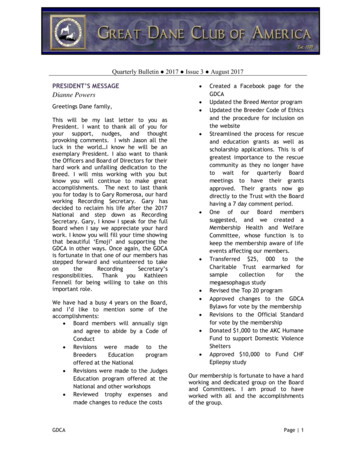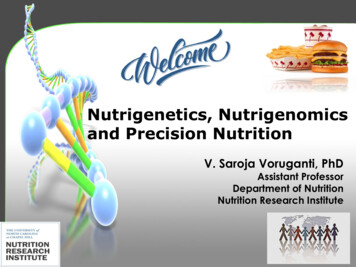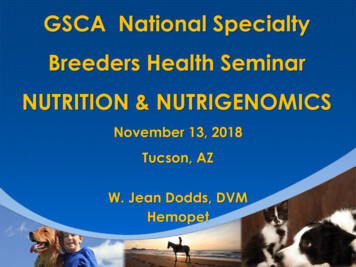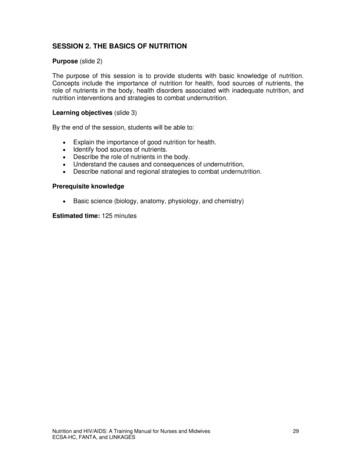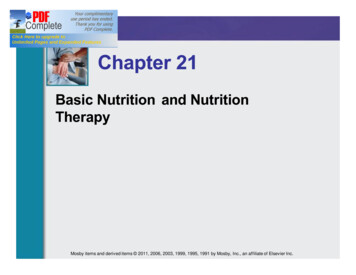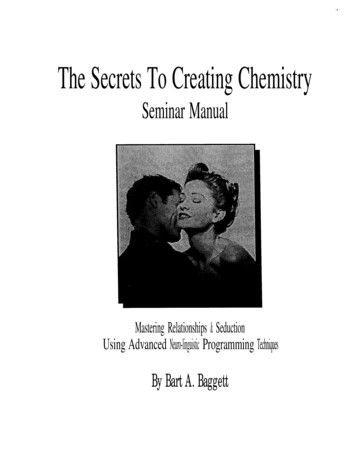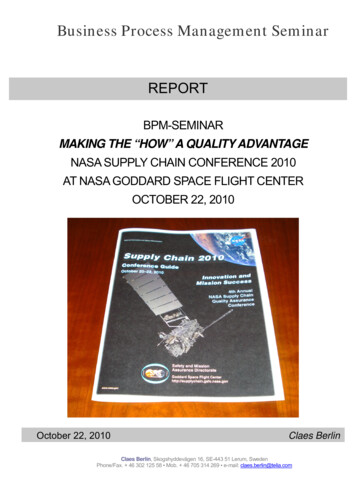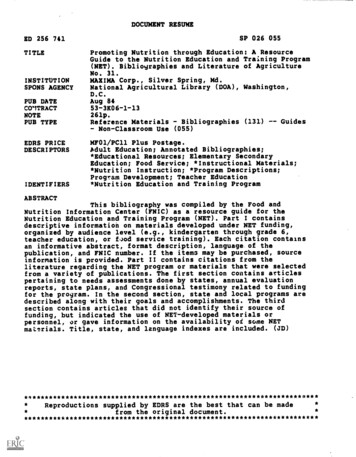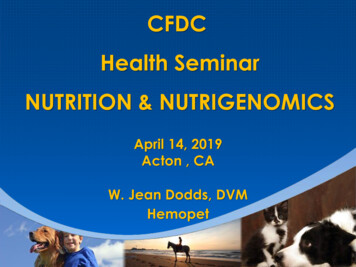
Transcription
CFDCHealth SeminarNUTRITION & NUTRIGENOMICSApril 14, 2019Acton , CAW. Jean Dodds, DVMHemopet
The Picture of Optimal Health
Canine Nutrigenomics: The NewScience of Feeding Your Dog forOptimum HealthW. Jean Dodds, DVMDiana R. Laverdure, MSDog Wise PublishingWenatchee, WA2015
Impact of Diet on Genome & Metabolism GOAL – holistically understand howdietary components interact with/withincells & organisms to develop newstrategies/ products that are nutritious &safe Nutrition is the most important factor forhuman and animal health Health is achieved by understandingmolecular individualized, functionalnutrition4
NutrigenomicsGoal: Optimize gene expression for good health – Functional Foods
Functional Nutrition, Foods & Superfoods Functional foods include certain botanicals, amino acids,vitamins and phytochemicals that activate disease-fightinggenes and suppress genes that promote disease Since each individual has an unique genome, a foodbenefitting one might not create the same effect foranother -- and could even prove harmful Commercial prescription diets might work for certainsubsets of animals, but they are too generalized to meetthe individual needs of every animal Commercial foods can send unhealthy messages to thecells as the functional effect of a food is only as good asthe sum total of ingredients
Dietary-Induced Hyperthyroidism In humans, excessive consumption of meat contaminated withthyroid tissue has resulted in exogenous hyperthyroidism Throat /gullet in raw meat fed to dogs & cats causes hyperthyroidism; first recognized in 2012 Dietary hyperthyroidism can be seen in dogs or cats fed red rawmeat diet or fresh or dried gullets (which include thyroid tissue).High circulating T4 concentration in a dog or cat, with or withoutsigns of hyperthyroidism, should prompt a review of the dietaryhistory. Clinical signs are readily reversed upon removing the thyroid contaminated food or treats.
Grain-Free Pet Foods, Taurine and CHD The US FDA stated on July 12, 2018 it is investigating a possible connectionbetween grain-free pet diets, taurine, and dilated cardiomyopathy(DCM), also called canine heart disease (CHD) However, much is still unknown, and various factors impact heart heath :Genetics, diet, scientific research to date, taurine needs for dogs vs cats,interaction between foods when passing through and within the body What do we know about taurine ? Taurine is an amino acid found in animal-based protein and plant sources like soy inamounts that vary with the type of meat or plant Taurine deficiency can lead to CHD in humans, cats and dogs Not an essential, food-sourced amino acid for dogs, but still present in pet foods Cats do need food-sourced taurine to prevent CHD; minimum standards by AAFCO
Even More on Taurine No effect of age, sex, body weight, body size, or diet was seen onplasma and whole blood taurine concentrations Mean whole blood taurine concentrations were lower in dogs fed dietscontaining whole grain rice, rice bran or barley The lowest whole blood concentrations were seen in dogs fed lamb orlamb meal and rice diets Plasma methionine and cysteine concentrations were lower in dogs feddiets with animal meals or turkey, and whole grain rice, rice bran orbarley Delaney SJ, Kass PH, Rogers QR, et al. Plasma and whole blood taurinein normal dogs of varying size fed commercially prepared food. J AnimPhysiol Anim Nutr, 2003: 87(5-6): 236–244. No research has established that grain-free diets can cause heartdisease in dogs
Measuring Taurine in Pets Need diagnostic laboratory experienced with the appropriatereference ranges for circulating taurine (see below). Specialsample preparation, storage and shipping is required usingsodium or lithium heparin anticoagulated tubes. If plasma taurinelevel is equivocal, whole blood taurine is measured tosubstantiate the diagnosis of deficiency Amino Acid Laboratory, University of California, Davis, 1020 Vet Med 3B, 1089Veterinary Medicine Drive, Davis, CA 95616; 530-752-5058; Fax /aal.htmlPlasma (nmol/ml)Normal RangeNo Known Riskfor Taurine DeficiencyWhole Blood (nmol/ml)Normal RangeNo Known Riskfor Taurine DeficiencyCat80-120 40300-600 200Dog60-120 40200-350 150
Confounding Factors Confluence (merging) foods Ingredients (quality, meat versus vegetarian; role of beetpulp, taurine, grain-free diets)Knight A, Leitsberger M. Vegetarian versusmeat-based diets for companion animals. Review. Animals 2016; 6: 20 pp. Homemade versus commercial Raw (freeze dried, dehydrated, high-pressure pasteurization) Contamination bacterial, fungal and parasite contamination, metals, thyroid hormone, etc Residual pesticides and herbicides glyphosate (Roundup ); chlorpyrifos, dicambra Aflatoxins and mycotoxins
More Confounding Factors Undeclared ingredients not on the label Critically assessed published discrepancies between ingredientsand labeling in commercial pet foods, including those with“novel” or “limited” ingredients and containing micronizedhydrolysates Found that the median mislabeling was 45 % of tested diets with arange of 33-83% for the “novel/limited” ingredients ones that areused for food elimination trials, and one hydrolyzed diet Olivry T, Mueller RS. Critically appraised topic on adverse foodreactions of companion animals (5): discrepancies betweeningredients and labeling in commercial pet foods. [BMC Vet Res2018: 14:24-28]
Golden Retriever Nutrition Data (2016-2018)ParameterNumber of DogsCommentsTotal Number with NutriscanTesting523None had cardiac diseaseor dysfunction; all healthy orhad itching and /or bowelissues *Raw Diet133 (25%)Variety of meats, fowl andfish plus some carbs andvegetablesGrain-Free Diet79 (15%)Same as raw groupHomemade Diet38 (7%)Same as raw groupReactive Foods on NutriscanTesting (24 key foods)523 (total results) and thecombination of Raw, Grainfree and Homemade dietgroups (250) yielded thesame breakdown ofreactive foodsHighest (54-60%) Turkey &White-Colored Fish.Medium (44-48%) Venison & Corn.Lowest (11%) Lamb & Nofood reactionsTotal Number in Data Base(all Diagnostics)22,192Includes any type ofdiagnostic test run atHemopet during the 2-yearperiod* 26 dogs were tested for whole blood taurine levels upon client request. All were mid-normalexcept 3 were slightly elevated (not supplemented with taurine beyond their diet level)
Raw vs Cooked DietsBenefits of raw Carnivores ancestrally consume raw meat, bones and viscera Controlled ingredient selection and sourcing if home prepared; safe food handling needed Higher in enzymes, vitamins, minerals and nutrient availability Improved skin, coat and breath; increased energy; enhanced immune function Reduced or eliminated ear infections; fewer, less bulky, less foul-smelling stools Reduced incidences of chronic diseaseBenefits of fresh cooked Controlled ingredient selection and sourcing; safe food handling needed Fresh, whole foods provide higher levels of nutrients than processed commercial foods Nutrients more bioavailable, and more species appropriate Improved skin, coat and breath; increased energy; enhanced immune function Reduced or eliminated ear infections; fewer, less bulky, less foul-smelling stools Reduced incidences of chronic disease
Raw vs Cooked Diets (cont’d)Negatives of raw May expose humans to higher bacterial contamination, especially for young, elderly and ill Proof needed that raw-fed dogs live healthier, longer lives Exposes vulnerable dogs to dangerous bacteria Home-prepared raw meat-based diets may be unbalanced, with deficiencies and/orexcesses of certain nutrients Unbalanced raw diets of concern for growing puppies Bones, even raw, pose risk of obstruction and perforationNegatives of fresh cooked Main negative risk if unbalanced of long-term vitamin/mineral deficiencies Opponents may be invested in mass-market commercial pet food industry Mainstream veterinarians often opposed to home-prepared diets Pet Food Recalls (Salmonella, Listeria, Campylobacter, and E. coli). Both human and petfood industries have recently been inundated with food recalls for contamination withmicrobes including bacteria, viruses and parasites
Summary Raw vs Cooked Foods Neither a balanced raw nor cooked diet is inherently“better” than the other As veterinarians, we see many dogs that thrive on raw fooddiets, while others that do less well on raw food thrive onfreshly prepared human-grade cooked foods We should always come back to the fact that every dog(and cat) is an individual, and that individual needs shouldoutweigh a preference to any one way of feeding
Functional Superfoods Functional superfoods include: berries , but not strawberries;coconut oil; curcumin; medicinal mushrooms; milk thistle;omega-3 fatty acids (EPA and DHA); pomegranates;probiotics; raw honey products (not suitable for the veryyoung); and spirulina (pre-biotic) Home-prepared diets require separate extra calcium,regardless of the diet’s quality Deficient nutrients that often need supplementing are linoleicacid; omega-3 fatty acids; selenium; vitamin B-6 (pyridoxine);vitamin D; vitamin E; and zinc
NUTRIGENOMICS Emerging science that studies the molecular relationshipsbetween nutrition and the response of genes in the genome inpromoting health Different diets alter gene expression, and production ofproteins/ metabolites Ideal diet contains variety, nutrient-dense, whole foods Specific nutrients affect body responses in a form defined as a“signature” Individual response “Molecular Dietary Signature”
BASIC CONCEPTS OFNUTRIGENOMICS Diet can be serious risk factor for a number of diseases Common dietary ingredients act on animal genomedirectly /indirectly, to alter gene expression/structure Degree of dietary influence on balance of healthy anddisease states depends on individual’s genetic makeup Certain diet-regulated genes play a role in onset, incidence,progression, and/or severity of chronic diseases Dietary intervention based on animal’s nutritionalrequirement/ status plus genotype used to prevent, mitigateor cure chronic disease
Do all foods suit all dogs ?
Thyroid Function, Diet & BehaviorFoods/Supplements important for thyroid function: Soy – dietary goitrogens, but anti-thyroid effect protected by iodine Iodine – vital to thyroid function; excess and deficiency can occur Zinc – critical to immune function, and health of skin Selenium – protects against oxidative damage; boosts immunity Vitamin E – neutralizes free radicals; protects against cancer, aging Vitamin B-6 (pyridoxine) – keeps CNS healthy, aids RBC function Vitamin D – balances cellular and humoral immunity, regulatesinsulin and glucose
Vitamin D Toxic Excess in Dry Pet Foods Recently, some 9 companies have recalled their dry petfoods for harmful excess levels of Vitamin D This vitamin D toxicosis had sickened at least 6 dogs, but todate according to the FDA none have died Some products contained about 70 times the intendedamount, which could cause kidney failure and death ifconsumed Other signs of vitamin D toxicity include: vomiting,anorexia, increased thirst and urination, excessive droolingand weight loss
Ultra-Trace Minerals in Commercial Dry Kibble Major and trace minerals in commercial pet foods areregulated by the NRC and AAFCO. But, ultra-trace minerals(aluminum, mercury, chromium, nickel, molybdenum and silica)are not. These can be cumulative and harmful, causing liverdamage, GI inflammation, and brain toxicity Recent study examined 49 OTC dry dog foods Aluminum in 46/49 foods was 38 times average human exposure Chromium was 30-fold the average human daily intake Molybdenum was 15 times more, but silica was similar in both Mercury (thimerosal) accumulates from vaccines[Bohn & Stoessel, American Veterinarian.com Dec 24, 2018]
Factors to Control Aging and Memory Functional foods that improve cognitive activity in agingdogs include vitamins E and C, and resveratrol (acting asantioxidants) along with a mixture of fruits and vegetablesto reduce free radical damage Alpha-lipoic acid L-carnitine (mitochondrial cofactors) Exercise in modest amount tasks to learn & perform Omega-3 fatty acids help improve brain health andfunction and slow loss of cognitive function with aging Requirement for essential nutrients increases not onlyduring periods of rapid growth or reproduction but also ingeriatrics, because immune function and bio-availabilityof nutrients generally wanes with aging
Future DirectionsNutrigenomics and Canine Health Simple tests for rancidity and antioxidant capacityshould permit dog owners and breeders to selectbetter foods Monitor for antioxidant levels Evaluate rancidity due to oxidation of foods – especiallykibble products – over time Development of functional foods, e.g. thosecontaining natural Nrf-2 activators, has great promise
Future DirectionsNutrigenomics for Canine Health (cont’d) The effects of other dietary variables, including functionalfoods and saturated vs unsaturated fats need to beevaluated Older, less healthy animals more likely to exhibit higher levelsof disease-related biomarkers. Also more likely to benefitfrom induction of antioxidant pathways Newer biomarkers, including metabolomic analyses,isoprostanes and miRNAs plus provide earlier assessment ofdiet-related health effects in younger animals
Some Nrf-2 Activators in Foods
BRAIN HEALTH & MEMORY10 foods for Brain Health and Memory Leafy greens (folate, vit. B 9) - kale, spinach, collard andmustard greens Cruciferous vegetables (folate, carotenoids) - broccoli,cauliflower, bok choy, Brussel sprouts Beans/ legumes (choline) Berries/cherries (anthocyanins, antioxidants, vits. C & E)Whole grains (gluten-free quinoa, millet, rice, soy, corn, flax,TEFF, tapioca)
Brain Health & Memory10 foods for brain health and memory (cont’d) Omega 3 fatty acids (anti-oxidant, anti-inflammatory) Nuts (omega fatty acids, vits. E & B6, folate, magnesium)CAUTION macademia, walnuts are unsafe for pets Seeds (zinc, choline, vit. E) Spices (anti-oxidant, anti-inflammatory)Yellow Squash, asparagus, tomatoes, carrots, beets (folate, vit.A, iron)29
Brain Health & MemoryOther Superfoods Eggs - high in quality protein andcholine for brain and memory Kiwis - antioxidant-rich, vit. A, C & E,potassium, high in fiber Quinoa - high in protein and fiber, iron,zinc, vit. E, selenium Salmon - high omega-3 and iron, lowcalorie and low saturated fat Sweet Potatoes - high in vit. A & C,calcium, potassium30
Brain Health & Memory Mediterranean type diet - fish, nuts (for dogs: not macadamia,walnut or hickory nuts; brazil nuts and cashews are high in fat;pistachios, pecans , almonds can be moldy (aflatoxins); some dogs peanut reactive); whole gluten-free grains; olive oil, fresh produce Avoid Trans Fats & Saturated Fats - less dairy, red meat, fried foodsHeart-Healthy diet - also good for the brainPlenty of Omega-3 Fatty Acids – causes 26% less brain lesionsSmaller meals throughout the day – helps digestionEat Fruits, Vegetables, and Berries - of various colorsGreen Tea - enhances memory and alertness; antiinflammatory; put on body and sores, in foods31
Avoiding Glutens Protect brain function in geriatrics and thosewith gluten intolerance by avoiding wheat,barley, rye, oats unless labeled gluten-free,kamut, spelt, farro, and couscous Linked with impairment of brain function,including learning disabilities, attentiondeficit-hyperactivity disorder, and memoryproblems Gluten sensitivity may manifest exclusively asa neurological disease32
Canine Cognitive Dysfunction IncontinenceConfusion/disorientation in familiar surroundingsIncreased sleeping/insomniaLoss of interest in people and eventsForgetfulness of housetraining habitsFailure to recognize familiar people and animalsWandering aimlessly/pacingLoss of appetite/forgetting to eatStaring into spaceDecreased activity levelLack of response to name/commandsFailure to pay attention
Improving Cognitive FunctionNutrients of benefit include: Milk thistle and SAMe (S-adenosylmethionine)Phosphatidylserine & PhosphatidylcholineMedium-chain triglycerides (MCTs)DHA and EPA omega-3 fatty acidsAnthocyanins (pigmented foods)Avoiding GlutensAvoiding carbs with high Glycemic Index34
Milk Thistle and SAMeSilibinin (milk thistle extract) preventsimpairment of both short-term memoryand recognition memory prevention for cancer as wellworks as antioxidant, protects brainfrom oxidative damageSAMe (S-adenosyl methionine)improves neuron membrane fluidity increases serotonin and dopaminemetabolites reduces effects of depression in peoplemay help Alzheimer’s patients35
Phosphatidylserine (PS) Phospholipid primarily from soy lecithin Commercial animal products combine PSwith gingko biloba, vit. E, pyridoxine (vit. B6)and grape-skin extract Improves canine cognitive function,decreases sleeping problems, apathy anddisorientationIncreases playful behavior and response tocommands Beneficial effects for dementia andcognitive dysfunction36
Phosphatidylcholine Phospholipid choline is critical for cellmembrane structure and function Increases production of acetylcholineHelps reverse signs of cognitive andother neurological disorders of agingpets37
Medium-Chain Triglycerides (MCTs) MCTs, like coconut oil, break down andabsorb rapidly, unlike fats; quick source ofnon-carbohydrate energy Readily cross blood-brain barrier, supplying20% of brain energy requirement Important for ketone production Helps age-related cognitive decline byproviding alternative source of brain energyHelp body use omega-3 fatty acids moreefficiently38
DHA & EPA Omega-3 Fatty Acids Fight obesity, decrease inflammation, combat arthritis and cancer, andpromote overall health Benefit neurotransmission and cognition, plus brain health andstructure, since the brain contains up to 60% fat Used together to benefit mood EPA from marine sources such as fish oil decrease the cytokines ofdepression Individuals reactive to white fish (including sardines and herring) orsalmon oils can use krill oil, anchovy oil, and plant oils (olive, moringa,sunflower, safflower, hemp)39
Anthocyanins (pigmented foods) Give berries their rich pigment;antioxidants; also benefitcognitive health of senior dogs Most potent is aronia, thechokeberry. Greaterantioxidant than all otherberries; anti-cancer; antibacterial, anti-viral and evenanti-diabetic; and antiinflammatory40
Avoiding CarbsWith High Glycemic Index (GI) Impaired glucose metabolism caused by sugary foods canpromote brain starvation, leading to memory problems, likecanine cognitive dysfunction Foods with high GI can also lead to hunger-related behavioralproblems Simple carbohydrates digest and absorb quickly (hence rapidrise and fall in blood sugar concentrations), so pets feel hungryagain quickly41
DIETARY DIAGNOSTICSFood Sensitivity -- Newer Testing Newer tests can use serum, saliva or feces ELISA or other immunoassay platforms Identify IgG, IgA , or immune complexes to foods in serum (poorlycorrelated to clinical signs) IgA or IgM antibodies to foods in saliva (excellent clinicalcorrelation) Antibodies to foods appear in saliva before GI tract clinical/biopsydiagnosis of IBD or “leaky gut syndrome” Saliva testing can thusreveal the latent or pre-clinical form of food sensitivity[Dodds, WJ JAHVMA, 49, Winter Issue , 32-43, 2017/2018; patented worldwide]
NUTRISCAN SUCCESS CASEDarby, 9 yr, S/F, 68 pounds, Old English Sheepdog Hypothyroid on thyroxine therapy; antihistamine Orange staining on head, ears; black skin eruptions Eating chicken & turkey , plus some fish & corn, veggies Removed these 4 foods , and head, ear & skin improved
Before EarWRONG FOODBefore CAN SUCCESS CASE (cont’d)Before Skin
NUTRISCAN SUCCESS CASE (cont’d)RIGHT FOODAfter EarAfter HeadNUTRISCANSUCCESSCASEAfter SkinAfter EarRIGHT FOODAfter HeadAfter Skin
BeforeBeforeHypothyroidism & Food Intolerance
AfterThyroid Therapy Nutriscan
BeforeAfter
BeforeAfter
Before -- Face Lesions -- Before
BeforeAfter
Before -- Eye Redness -- After
IsoprostaneBiomarkerAssay
“Let food be thy medicine andmedicine be thy food.”Hippocrates
Nutrigenomics and Canine Health Simple tests for rancidity and antioxidant capacity should permit dog owners and breeders to select better foods Monitor for antioxidant levels Evaluate rancidity due to oxidation of foods –especially kibble produc
